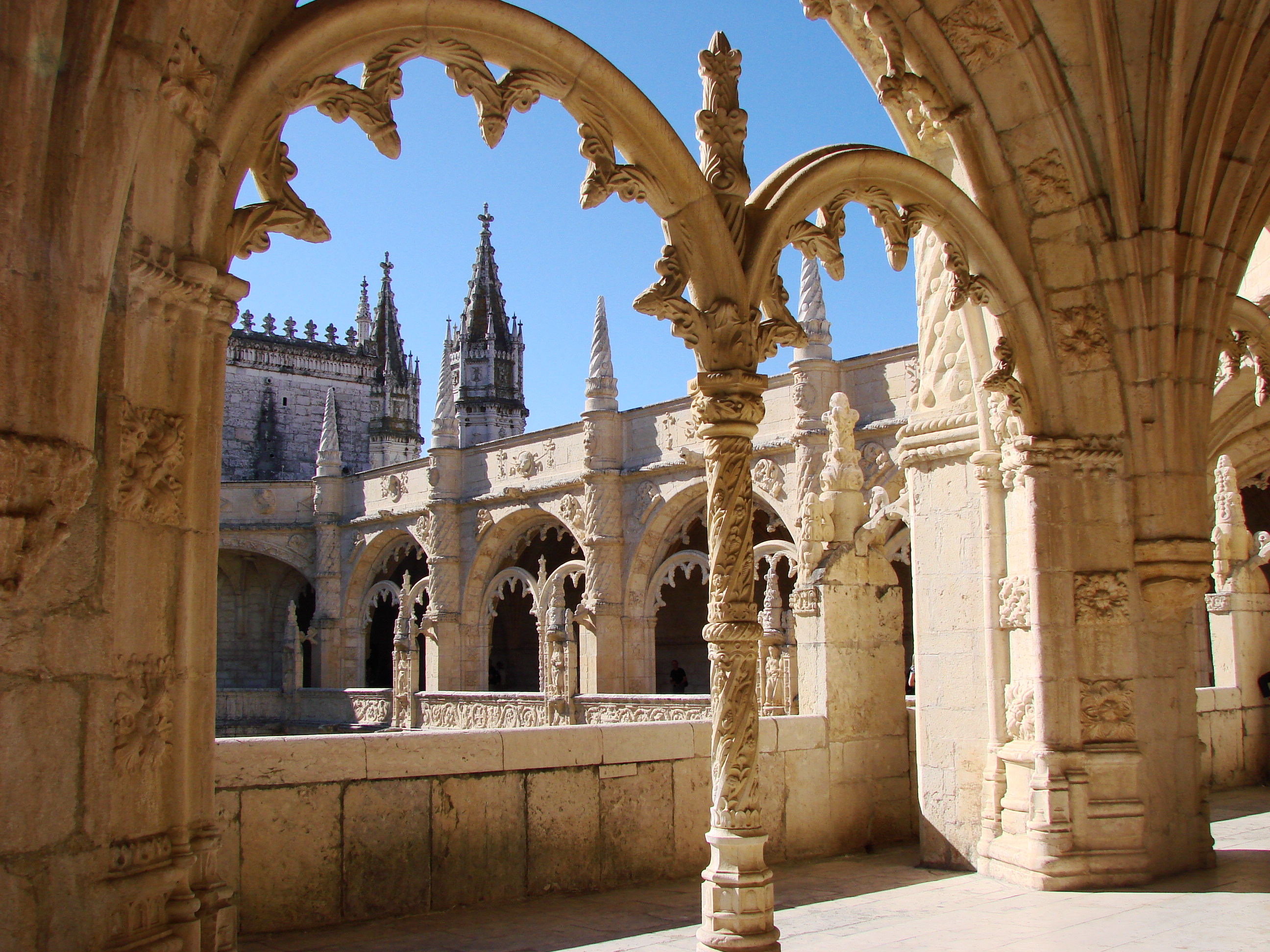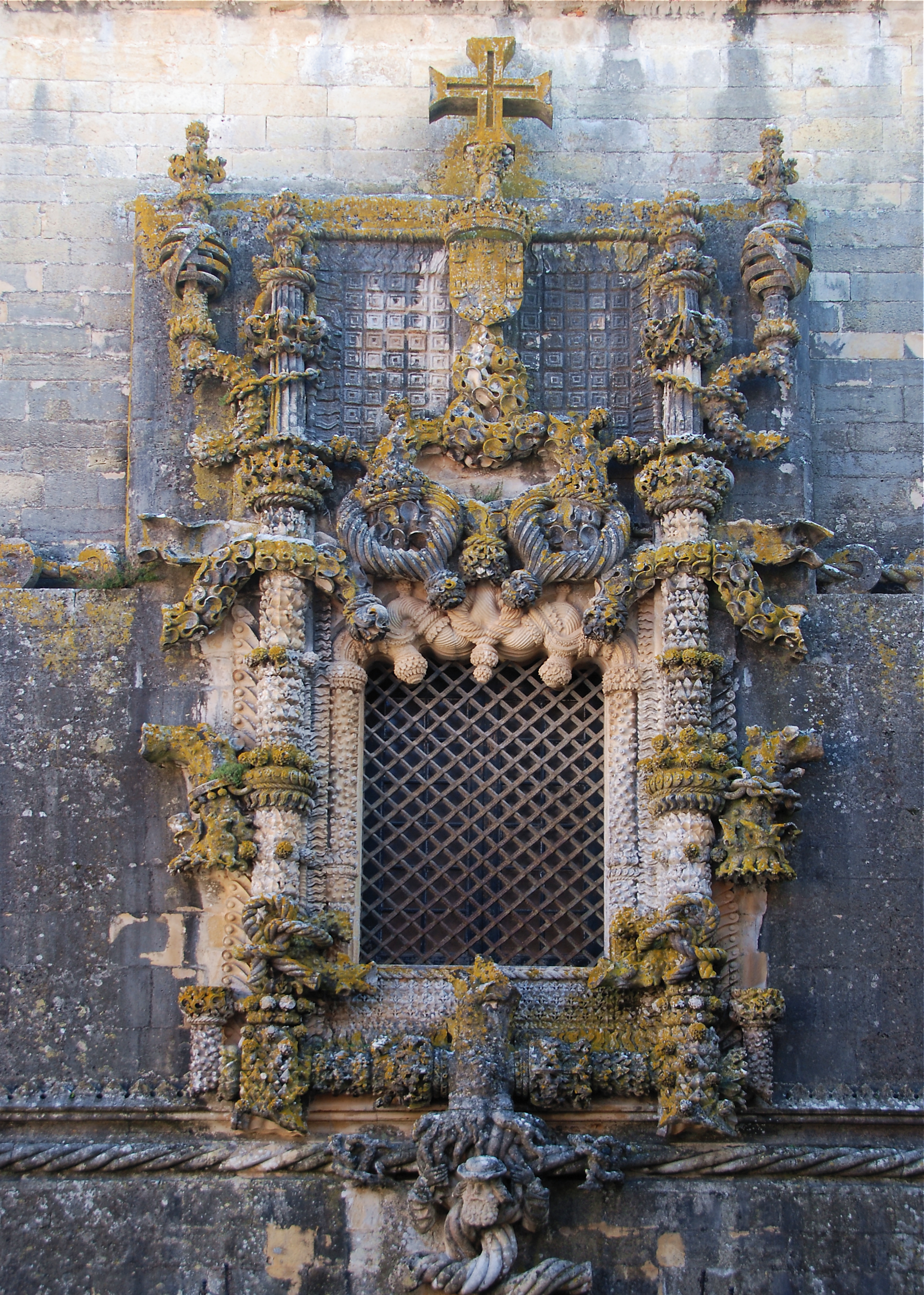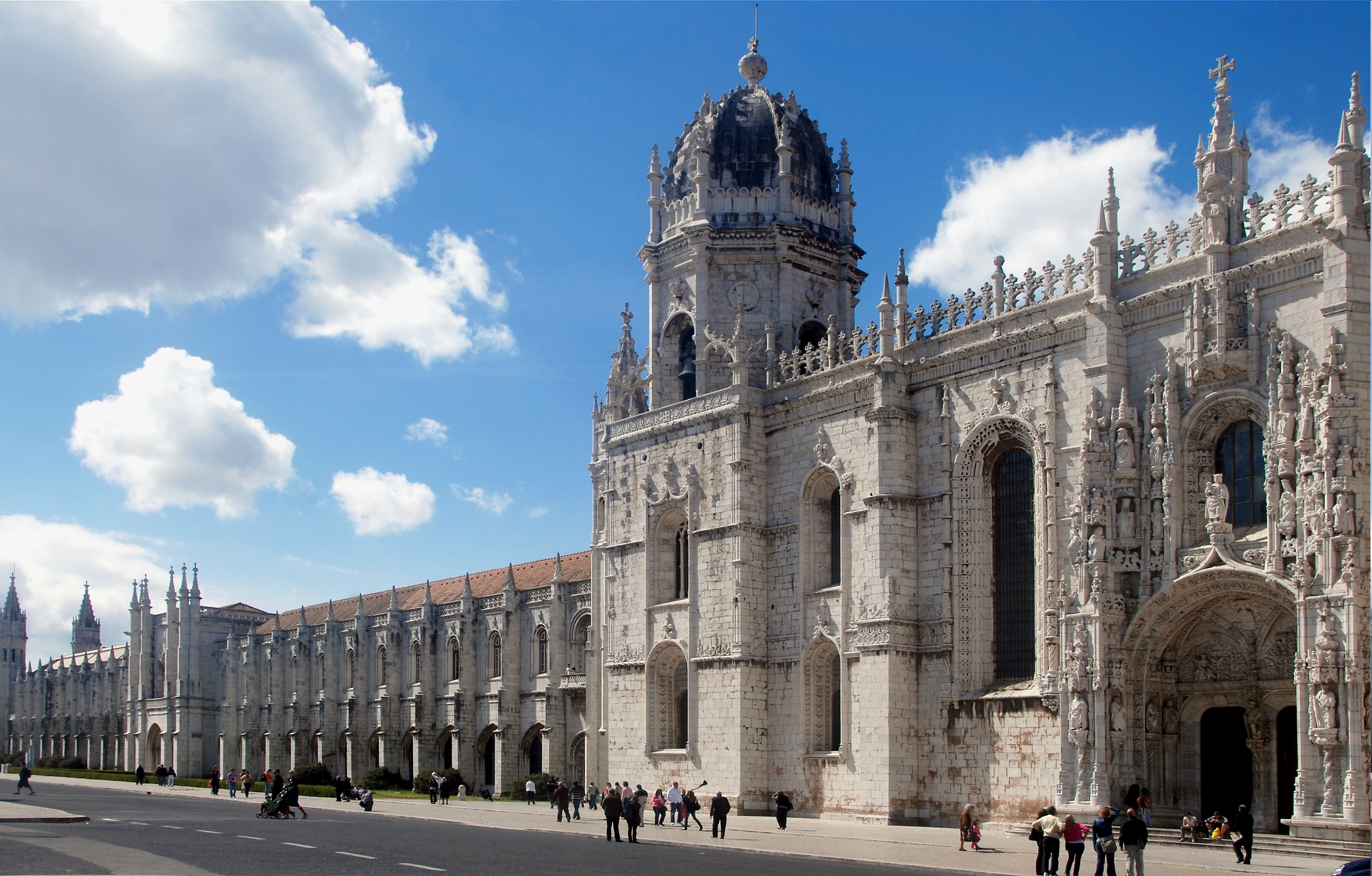Manueline on:
[Wikipedia]
[Google]
[Amazon]

 The Manueline ( pt, estilo manuelino, ), occasionally known as Portuguese late Gothic, is the sumptuous, composite Portuguese architectural style originating in the 16th century, during the Portuguese Renaissance and Age of Discoveries. Manueline architecture incorporates maritime elements and representations of the discoveries brought from the voyages of
The Manueline ( pt, estilo manuelino, ), occasionally known as Portuguese late Gothic, is the sumptuous, composite Portuguese architectural style originating in the 16th century, during the Portuguese Renaissance and Age of Discoveries. Manueline architecture incorporates maritime elements and representations of the discoveries brought from the voyages of
 This decorative style is characterized by virtuoso complex ornamentation in portals, windows, columns and arcades. In its end period, it tended to become excessively exuberant as in Tomar.
Several elements appear regularly in these intricately carved stoneworks:
* elements used on ships: the
This decorative style is characterized by virtuoso complex ornamentation in portals, windows, columns and arcades. In its end period, it tended to become excessively exuberant as in Tomar.
Several elements appear regularly in these intricately carved stoneworks:
* elements used on ships: the
 When King Manuel I died in 1521, he funded 62 construction projects. However, much original Manueline architecture in Portugal was lost or damaged beyond restoration in the
When King Manuel I died in 1521, he funded 62 construction projects. However, much original Manueline architecture in Portugal was lost or damaged beyond restoration in the  Outside Lisbon, the church and chapter house of the Convent of Christ at Tomar (designed by Diogo de Arruda) is a major Manueline monument. In particular, the large window of the chapter house, with its fantastic sculptured organic and twisted rope forms, is one of the most extraordinary achievements of the Manueline style.
Other major Manueline monuments include the arcade screens of the Royal Cloister (designed by Diogo Boitac) and the Unfinished Chapels (designed by Mateus Fernandes) at the Monastery of Batalha and the Royal Palace of Sintra.
Other remarkable Manueline buildings include the church of the Monastery of Jesus of SetĂșbal (one of the earliest Manueline churches, also designed by Diogo Boitac), the Santa Cruz Monastery in Coimbra, the main churches in GolegĂŁ, Vila do Conde, Moura,
Outside Lisbon, the church and chapter house of the Convent of Christ at Tomar (designed by Diogo de Arruda) is a major Manueline monument. In particular, the large window of the chapter house, with its fantastic sculptured organic and twisted rope forms, is one of the most extraordinary achievements of the Manueline style.
Other major Manueline monuments include the arcade screens of the Royal Cloister (designed by Diogo Boitac) and the Unfinished Chapels (designed by Mateus Fernandes) at the Monastery of Batalha and the Royal Palace of Sintra.
Other remarkable Manueline buildings include the church of the Monastery of Jesus of SetĂșbal (one of the earliest Manueline churches, also designed by Diogo Boitac), the Santa Cruz Monastery in Coimbra, the main churches in GolegĂŁ, Vila do Conde, Moura,

File:Capela de S Miguel Portal Manuelino Universidade de Coimbra IMG 0666.JPG, Doorway at the University of Coimbra
File:Elvas-NÂȘ SÂȘ AsunciĂłn 17.jpg, Doorframe in a church in Elvas
File:Igreja Matriz da Golega 96a.jpg, Doorframe of a church in GolegĂŁ
File:Evora, Palace (3921100752).jpg, Royal palace at Ăvora
File:Evora, Palace (3921098252).jpg, Royal palace at Ăvora, gallery.
File:Linhares - detalhe manuelino.jpg, Manueline furnishings of a 16th century Portuguese countryside house
File:Portal manuelino - Ayuntamientro de Olivenza.jpg, Manueline doorframe in Olivença, Spain.
File:Manueline Window at Pinhel.jpg, Manueline windowframe in Pinhel
File:Evora-ManuelineWindow.jpg, Windowframe in Ăvora
File:Bottega di lisbona, fonte bicefala con teste coronate e stemmi regali del portogallo, 1510-25 ca. 01.jpg, "Bicephalous Fountain", displaying both the heads of King Manuel and the Queen, and an armillary sphere, the royal emblem.
File:1 Exterior da igreja manuelina Convento de Cristo IMG 9479.jpg, Decorative motifs in the Monastery of Tomar
File:Goa-RosarioChurch.jpg, Manueline church in Goa, India.
File:TracerĂas gĂłticas (Claustro de D. JoĂŁo I, Monasterio de Batalha).jpg, Cloyster at the Batalha monastery
File:Mosteiro da Batalha 19a.jpg, Detail of decorative motifs in the Batalha Monastery
File:Mosteiro da Batalha 14a.jpg, Monastery of Batalha
File:Vista geral da capela.jpg, Chapel in Belém, Lisbon.
File:Capela de São Jerónimo 7601.jpg, Detail of the chapel in Belém.
File:Castelo de Alvito (Portugal)2.jpg, Castle of Alvito, with Manueline elements.
File:Solar da Sempre Noiva - Portugal (297263101).jpg, Sempre Noiva manor.
File:Paço dos Henriques de Transtùmara - Alcåçovas -Portugal (5623992584).jpg, Manor of the Henriques de Traståmaras, in Alvor.

Vasco da Gama
Vasco da Gama, 1st Count of Vidigueira (; ; c. 1460s â 24 December 1524), was a Portuguese explorer and the first European to reach India by sea.
His initial voyage to India by way of Cape of Good Hope (1497â1499) was the first to link E ...
and Pedro Ălvares Cabral. This innovative style synthesizes aspects of Late Gothic Flamboyant architecture with original motifs and influences of the Plateresque, MudĂ©jar, Italian, and Flemish architecture. It marks the transition from Late Gothic to Renaissance. The construction of churches and monasteries in Manueline was largely financed by proceeds of the lucrative spice trade with Africa and India.
The style was given its name, many years later, by Francisco Adolfo de Varnhagen, Viscount of Porto Seguro, in his 1842 book ''Noticia historica e descriptiva do Mosteiro de Belem, com um glossario de varios termos respectivos principalmente a architectura gothica'', in his description of the JerĂłnimos Monastery. Varnhagen named the style after King Manuel I, whose reign (1495â1521) coincided with its development. The style was much influenced by the astonishing successes of the voyages of discovery
Voyage(s) or The Voyage may refer to:
Literature
*''Voyage : A Novel of 1896'', Sterling Hayden
* ''Voyage'' (novel), a 1996 science fiction novel by Stephen Baxter
*''The Voyage'', Murray Bail
* "The Voyage" (short story), a 1921 story by K ...
of Portuguese navigators, from the coastal areas of Africa to the discovery of Brazil and the ocean routes to the Far East.
Although the period of this style did not last long (from 1490 to 1520), it played an important part in the development of Portuguese art. The influence of the style outlived the king. Celebrating the newly maritime power, it manifested itself in architecture (churches, monasteries, palaces, castles) and extended into other arts such as sculpture, painting, works of art made of precious metals, faience and furniture.
Characteristics
 This decorative style is characterized by virtuoso complex ornamentation in portals, windows, columns and arcades. In its end period, it tended to become excessively exuberant as in Tomar.
Several elements appear regularly in these intricately carved stoneworks:
* elements used on ships: the
This decorative style is characterized by virtuoso complex ornamentation in portals, windows, columns and arcades. In its end period, it tended to become excessively exuberant as in Tomar.
Several elements appear regularly in these intricately carved stoneworks:
* elements used on ships: the armillary
An armillary sphere (variations are known as spherical astrolabe, armilla, or armil) is a model of objects in the sky (on the celestial sphere), consisting of a spherical framework of rings, centered on Earth or the Sun, that represent lines ...
sphere (a navigational instrument and the personal emblem of Manuel I and also a symbol of the cosmos), spheres, anchors, anchor chains, ropes and cables.
* elements from the sea, such as shells, pearls and strings of seaweed.
* botanical motifs such as laurel branches, oak leaves, acorns, poppy capsules, corncobs, and thistles.
* symbols of Christianity such as the cross of the Order of Christ (former Knights Templar), the military order that played a prominent role and helped finance the first voyages of discovery. The cross of this order decorated the sails of the Portuguese ships.
* elements from newly discovered lands (such as the tracery in the Royal Cloister of the Batalha Monastery, suggesting Islamic filigree
Filigree (also less commonly spelled ''filagree'', and formerly written ''filigrann'' or ''filigrene'') is a form of intricate metalwork used in jewellery and other small forms of metalwork.
In jewellery, it is usually of gold and silver, ma ...
work, influenced by buildings in India)
* columns carved like twisted strands of rope
* semicircular arches (instead of Gothic pointed arches) of doors and windows, sometimes consisting of three or more convex curves
* multiple pillars
* eight-sided capitals
* lack of symmetry
* conical pinnacle
A pinnacle is an architectural element originally forming the cap or crown of a buttress or small turret, but afterwards used on parapets at the corners of towers and in many other situations. The pinnacle looks like a small spire. It was mainly ...
s
* bevelled crenellations
* ornate portals with niches or canopies.
Examples
 When King Manuel I died in 1521, he funded 62 construction projects. However, much original Manueline architecture in Portugal was lost or damaged beyond restoration in the
When King Manuel I died in 1521, he funded 62 construction projects. However, much original Manueline architecture in Portugal was lost or damaged beyond restoration in the 1755 Lisbon earthquake
The 1755 Lisbon earthquake, also known as the Great Lisbon earthquake, impacted Portugal, the Iberian Peninsula, and Northwest Africa on the morning of Saturday, 1 November, Feast of All Saints, at around 09:40 local time. In combination with ...
and subsequent tsunami. In Lisbon
Lisbon (; pt, Lisboa ) is the capital and largest city of Portugal, with an estimated population of 544,851 within its administrative limits in an area of 100.05 km2. Grande Lisboa, Lisbon's urban area extends beyond the city's administr ...
, the Ribeira Palace, the residence of King Manuel I, and the Hospital Real de Todos os Santos were destroyed, along with several churches. The city, however, still has outstanding examples of the style in the Jerónimos Monastery (mainly designed by Diogo Boitac and João de Castilho) and in the small fortress of the Belém Tower (designed by Francisco de Arruda). Both are located close to each other in the Belém neighbourhood. The portal of the Church of Nossa Senhora da Conceição Velha, in downtown Lisbon, has also survived destruction.
 Outside Lisbon, the church and chapter house of the Convent of Christ at Tomar (designed by Diogo de Arruda) is a major Manueline monument. In particular, the large window of the chapter house, with its fantastic sculptured organic and twisted rope forms, is one of the most extraordinary achievements of the Manueline style.
Other major Manueline monuments include the arcade screens of the Royal Cloister (designed by Diogo Boitac) and the Unfinished Chapels (designed by Mateus Fernandes) at the Monastery of Batalha and the Royal Palace of Sintra.
Other remarkable Manueline buildings include the church of the Monastery of Jesus of SetĂșbal (one of the earliest Manueline churches, also designed by Diogo Boitac), the Santa Cruz Monastery in Coimbra, the main churches in GolegĂŁ, Vila do Conde, Moura,
Outside Lisbon, the church and chapter house of the Convent of Christ at Tomar (designed by Diogo de Arruda) is a major Manueline monument. In particular, the large window of the chapter house, with its fantastic sculptured organic and twisted rope forms, is one of the most extraordinary achievements of the Manueline style.
Other major Manueline monuments include the arcade screens of the Royal Cloister (designed by Diogo Boitac) and the Unfinished Chapels (designed by Mateus Fernandes) at the Monastery of Batalha and the Royal Palace of Sintra.
Other remarkable Manueline buildings include the church of the Monastery of Jesus of SetĂșbal (one of the earliest Manueline churches, also designed by Diogo Boitac), the Santa Cruz Monastery in Coimbra, the main churches in GolegĂŁ, Vila do Conde, Moura, Caminha
Caminha () is a municipality in the north-west of Portugal, 21 km north from Viana do Castelo, located in the Viana do Castelo District. The population in 2011 was 16,684, in an area of 136.52 kmÂČ.
Caminha is subdivided into 14 civil pa ...
, Olivença and portions of the cathedrals of Braga (main chapel), Viseu (rib vaulting of the nave) and Guarda (main portal, pillars, vaulting). Civil buildings in Manueline style exist in Ăvora (home to the Ăvora Royal Palace of 1525, by Pedro de Trillo, Diogo de Arruda and Francisco de Arruda) and the Castle of Ăvoramonte of 1531), Viana do Castelo, GuimarĂŁes
GuimarĂŁes () is a city and municipality located in northern Portugal, in the district of Braga.
Its historic town centre has been listed as a UNESCWorld Heritage Sitesince 2001, in recognition for being an "exceptionally well-preserved and a ...
and some other towns.
The style was extended to the decorative arts and spread throughout the Portuguese Empire, to the islands of the Azores, Madeira
)
, anthem = ( en, "Anthem of the Autonomous Region of Madeira")
, song_type = Regional anthem
, image_map=EU-Portugal_with_Madeira_circled.svg
, map_alt=Location of Madeira
, map_caption=Location of Madeira
, subdivision_type=Sovereign st ...
, enclaves in North Africa, Brazil, Goa in Portuguese India
The State of India ( pt, Estado da Ăndia), also referred as the Portuguese State of India (''Estado PortuguĂȘs da Ăndia'', EPI) or simply Portuguese India (), was a state of the Portuguese Empire founded six years after the discovery of a se ...
and even Macau, China. Its influence is apparent in southern Spain, the Canary Islands, North Africa and the former Spanish colonies of Peru and Mexico.
Famous Manueline artists
Architects
* Diogo Boitac * Mateus Fernandes * Diogo de Arruda * Francisco de Arruda * JoĂŁo de CastilhoPainters
* Vasco Fernandes * Jorge Afonso * CristĂłvĂŁo de Figueiredo *Garcia Fernandes
Garcia Fernandes (died ''c.'' 1565) was a Portuguese Renaissance painter. Like many of painters of the time, Garcia Fernandes was a pupil in the Lisbon workshop of Jorge Afonso, who was the court painter of King Manuel I.
In the 1530s he worked ...
* GregĂłrio Lopes
GregĂłrio Lopes (''c.'' 1490 – 1550) was one of the most important Renaissance painters from Portugal.
GregĂłrio Lopes was educated in the workshop of Jorge Afonso, the court painter of King Manuel I. Later he himself became court painter f ...
Gallery

See also
*Neo-Manueline
Neo-Manueline is a revival style of architecture which drew from the 16th century Manueline Late Gothic architecture of Portugal. Neo-Manueline constructions have been built across Portugal, Brazil, and the Lusophone world (the former Portuguese ...
* Portuguese Architecture
References
*Atanåzio, ''A Arte do Manuelino'', Lisbon, Presença, 1984. *Turner, J., '' Grove Dictionary of Art'', Macmillan Publishers Ltd., 1996; *''The Rough Guide to Portugal'', March 2005, 11th edition, *Smith, Robert C.,'' The Art of Portugal 1500-1800''; Weidenfeld & Nicolson, London, 1968 {{Gothic architecture * Architectural styles Architectural history Maritime history of Portugal Architecture in Portugal